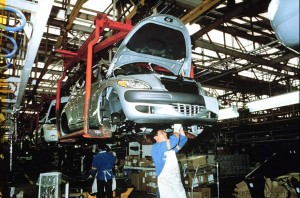
CEO Sergio Marchionne is signalling Chrysler must find a way to eliminate the 2-tier union wage structure.
Despite the significant cost savings it is bringing to the smallest of the domestic automakers, Chrysler CEO Sergio Marchionne signaled that the maker’s two-tier wage structure is something he plans to eliminate in the not-too-distant future.
About one in eight of Chrysler’s 26,000 union workers in the U.S. currently fall into the second tier, earning about half as much as more senior members of the United Auto Workers Union – a figure expected to grow to at least one in four by the time the newly ratified 4-year UAW contract expires in 2015, said Marchionne during a conference call.
The union failed to eliminate the two-tier structure during its recent contract talks with Chrysler, General Motors and Ford, though it did win so-called “new hires” a modest increase of about $3 an hour in wages and some additional benefits. But in an unexpected turn, Marchionne suggested that having multiple grades is “structurally undesirable.”
“This economic disparity between people on the line is not something that can go on indefinitely,” he told a group of reporters and automotive industry analysts. But he also suggested that workers will need to find a way to offset a return to a single pay grade by taking an increased stake in the financial vitality of Chrysler.
The idea of having a lower tier of employees who earn less than the typical line worker has traditionally been anathema to the UAW. But that resistance was lowered during the last round of negotiations, in 2007, as it became apparent workers needed to provide some assistance as the industry plunged into what ultimately turn out to be its worst downturn since the Great Depression.
Eliminating the two-tier structure was a key goal for the union going into this year’s talks with the Detroit Big Three – each of whom negotiates its own agreement with the UAW, though the first maker to settle usually provides the pattern for a settlement elsewhere. With the maker’s holding firm that the 2011 contract could not significantly boost labor costs, labor negotiators reluctantly accepted the two-tier approach would have to continue, at least for now.
That has not been well received. Workers at General Motors approved their new agreement by a much narrower margin than in past years and the vote at Ford appeared to be going against that maker’s tentative contract until union leaders – including President Bob King – stepped in to lobby workers to vote “yes.”
At Chrysler, the agreement also was approved by a narrowed margin, and members of a small, higher tier of skilled tradesmen actually rejected their portion of the settlement – forcing UAW leaders to override their vote using a procedural process.
The new Detroit contracts exclude wage increases for veteran workers – opting for bonuses instead. Second-tier workers did get a modest pay hike and improved benefits, however.
Under the old contract, they were making as little as $14 an hour. On average they will get about $3 an hour more by 2015, with the best-paid among them to see wages rise to slightly more than $19 an hour. But that will still be significantly less than veteran workers.
Currently, noted Marchionne during the conference call, about 13% of Chrysler workers are classified in the second tier. By 2015, “the number will be 25% or even higher,” he added.
The executive, who also serves as CEO of Chrysler’s Italian alliance partner Fiat, is well aware of the potential problems having workers standing side-by-side on the making distinctly difference wages. And there is little doubt that, should the industry’s fortunes continue to improve, the disparity will become an even more angry rallying cry for the UAW in 2015.
The four years of the current contract will provide “ample runway to start the dialogue by the time we get together again in 2015,” said Marchionne, adding that Chrysler will “have to provide an upside for workers as long as the company performs and delivers value.”
But what happens if things aren’t going so well? The Canadian-educated executive suggested that the quid-pro-quo might be for the UAW to tie more of workers’ wages and benefits to the health of the company. Indeed, the new Chrysler contract sets a corporate performance target for a significant chunk of the bonuses workers can receive.
The goal, he believes is to “accept the downside while rewarding people on the upside.”
Meanwhile, it is likely that Chrysler will also demand the UAW eliminate the distinction between regular line workers and skilled trades workers as part of any agreement that drops the lower, second-tier category.
Officials at General Motors and Ford have not discussed their long-term views on the two-tier wage structure – though with Marchionne laying out his own position it is likely to become even more of a topic in behind-the-scenes discussions between now and 2015.
